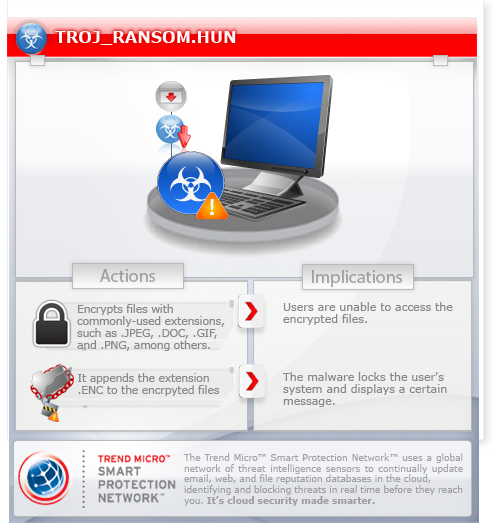TROJ_RANSOM.HUN
Troj/KillProc-N (Sophos) ,Trojan:Win32/Twirlwind (Microsoft) ,Win32/LockScreen.BFK trojan (Eset) ,Trojan.Ransomcrypt (Symantec) ,Trojan.Win32.Generic!BT (Sunbelt)
Windows 2000, Windows Server 2003, Windows XP (32-bit, 64-bit), Windows Vista (32-bit, 64-bit), Windows 7 (32-bit, 64-bit)


Threat Type: Trojan
Destructiveness: No
Encrypted: Yes
In the wild: Yes
OVERVIEW
Downloaded from the Internet
This ransomware variant targets users in Hungary. It locks users' computers and lists the encrypted file types. It also lists steps to unlock the files, along with the ransom amount.
To get a one-glance comprehensive view of the behavior of this Trojan, refer to the Threat Diagram shown below.

This Trojan arrives on a system as a file dropped by other malware or as a file downloaded unknowingly by users when visiting malicious sites.
TECHNICAL DETAILS
582,144 bytes
EXE
Yes
20 Feb 2014
Terminates processes, Displays graphics/image
Arrival Details
This Trojan arrives on a system as a file dropped by other malware or as a file downloaded unknowingly by users when visiting malicious sites.
Installation
This Trojan drops the following files:
- %System Root%\w.bmp
(Note: %System Root% is the root folder, which is usually C:\. It is also where the operating system is located.)
It drops the following file(s)/component(s):
- %Windows%\system\cl32.dll
(Note: %Windows% is the Windows folder, which is usually C:\Windows.)
It drops the following copies of itself into the affected system:
- %Windows%\system\csrss.exe
(Note: %Windows% is the Windows folder, which is usually C:\Windows.)
It adds the following processes:
- iexplore.exe
Launch http://szelvesz.2u.se/hun
Autostart Technique
This Trojan adds the following registry entries to enable its automatic execution at every system startup:
HKEY_LOCAL_MACHINE\Software\Microsoft\
Windows\CurrentVersion\Run
MS = "{Malware Path}\{Malware Filename}.exe}"
Other System Modifications
This Trojan adds the following registry keys:
HKEY_LOCAL_MACHINE\SOFTWARE\Microsoft\
Windows NT\CurrentVersion\Image File Execution Options\
cmd.exe
HKEY_LOCAL_MACHINE\SOFTWARE\Microsoft\
Windows NT\CurrentVersion\Image File Execution Options\
command.com
HKEY_LOCAL_MACHINE\SOFTWARE\Microsoft\
Windows NT\CurrentVersion\Image File Execution Options\
dllhost.exe
HKEY_LOCAL_MACHINE\SOFTWARE\Microsoft\
Windows NT\CurrentVersion\Image File Execution Options\
mbam.exe
HKEY_LOCAL_MACHINE\SOFTWARE\Microsoft\
Windows NT\CurrentVersion\Image File Execution Options\
msconfig.exe
HKEY_LOCAL_MACHINE\SOFTWARE\Microsoft\
Windows NT\CurrentVersion\Image File Execution Options\
regedit.exe
HKEY_LOCAL_MACHINE\SOFTWARE\Microsoft\
Windows NT\CurrentVersion\Image File Execution Options\
rstrui.exe
HKEY_LOCAL_MACHINE\SOFTWARE\Microsoft\
Windows NT\CurrentVersion\Image File Execution Options\
taskmgr.exe
Process Termination
This Trojan terminates the following processes if found running in the affected system's memory:
- taskmgr.exe
- msconfig.exe
- rundll32.exe
- cmd.exe
- mbam.exe
- rstrui.exe
Other Details
This Trojan encrypts files with the following extensions:
- *.jpeg
- *.jpg
- *.doc
- *.png
- *.gif
- *.mp3
- *.mp4
- *.wav
- *.docx
- *.rtf
- *.txt
- *.pps
- *.ppt
- *.pptx
- *.m4a
- *.mid
- *.wmv
- *.wma
- *.mpg
- *.mov
- *.avi
- *.3gp
- *.psd
- *.xls
- *.xlxs
- *.html
- *.php
- *.zip
- *.rar
- *.bak
It requires the existence of the following files to properly run:
- {Malware Path}\CL32.dll
NOTES:
This Trojan creates the following registry entries to prevent execution of system and security tools:
HKEY_LOCAL_MACHINE\SOFTWARE\Microsoft\
Windows NT\CurrentVersion\Image File Execution Options\{app name}
Debugger = "%System Root%\die.exe"
The variable {app name} may be any of the following:
- cmd.exe
- command.com
- dllhost.exe
- mbam.exe
- msconfig.exe
- regedit.exe
- rstrui.exe
- taskmgr.exe
It appends .ENC to encrpyted files. It locks the user's system and displays the following:

SOLUTION
9.700
10.618.05
20 Feb 2014
10.619.00
20 Feb 2014
Step 1
Before doing any scans, Windows XP, Windows Vista, and Windows 7 users must disable System Restore to allow full scanning of their computers.
Step 2
Restart in Safe Mode
Step 3
Delete this registry key
Important: Editing the Windows Registry incorrectly can lead to irreversible system malfunction. Please do this step only if you know how or you can ask assistance from your system administrator. Else, check this Microsoft article first before modifying your computer's registry.
- In HKEY_LOCAL_MACHINE\SOFTWARE\Microsoft\Windows NT\CurrentVersion\Image File Execution Options
- cmd.exe
- cmd.exe
- In HKEY_LOCAL_MACHINE\SOFTWARE\Microsoft\Windows NT\CurrentVersion\Image File Execution Options
- command.com
- command.com
- In HKEY_LOCAL_MACHINE\SOFTWARE\Microsoft\Windows NT\CurrentVersion\Image File Execution Options
- dllhost.exe
- dllhost.exe
- In HKEY_LOCAL_MACHINE\SOFTWARE\Microsoft\Windows NT\CurrentVersion\Image File Execution Options
- mbam.exe
- mbam.exe
- In HKEY_LOCAL_MACHINE\SOFTWARE\Microsoft\Windows NT\CurrentVersion\Image File Execution Options
- msconfig.exe
- msconfig.exe
- In HKEY_LOCAL_MACHINE\SOFTWARE\Microsoft\Windows NT\CurrentVersion\Image File Execution Options
- regedit.exe
- regedit.exe
- In HKEY_LOCAL_MACHINE\SOFTWARE\Microsoft\Windows NT\CurrentVersion\Image File Execution Options
- rstrui.exe
- rstrui.exe
- In HKEY_LOCAL_MACHINE\SOFTWARE\Microsoft\Windows NT\CurrentVersion\Image File Execution Options
- taskmgr.exe
- taskmgr.exe
Step 4
Delete this registry value
Important: Editing the Windows Registry incorrectly can lead to irreversible system malfunction. Please do this step only if you know how or you can ask assistance from your system administrator. Else, check this Microsoft article first before modifying your computer's registry.
- In HKEY_LOCAL_MACHINE\Software\Microsoft\Windows\CurrentVersion\Run
- MS = "{Malware Path}\{Malware Filename}.exe}"
- MS = "{Malware Path}\{Malware Filename}.exe}"
Step 5
Search and delete this file
- %System Root%\w.bmp
Step 6
Restart in normal mode and scan your computer with your Trend Micro product for files detected as TROJ_RANSOM.HUN. If the detected files have already been cleaned, deleted, or quarantined by your Trend Micro product, no further step is required. You may opt to simply delete the quarantined files. Please check this Knowledge Base page for more information.
Did this description help? Tell us how we did.

